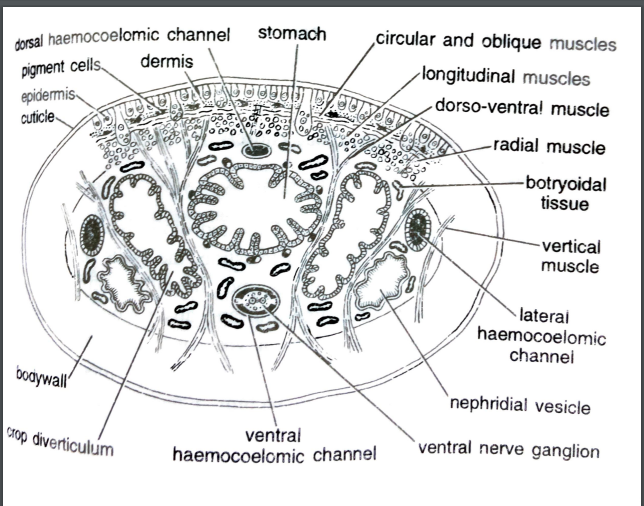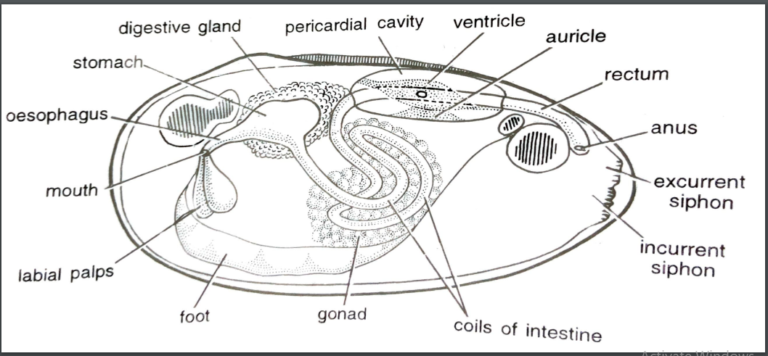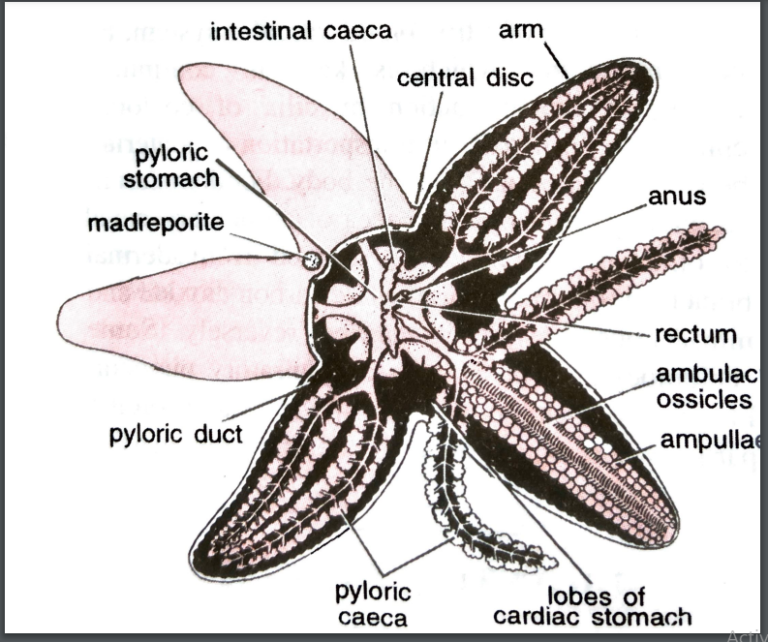PATTERN OF FEEDING AND DIGESTION IN HIGEHER INVERTEBRATES
INTRODUCTION
- There are numerous physical, chemical as well as mechanical process by which invertebrates capture food and passes it to their respective digestive organs. For this purpose different organism utilizes different body organs such as tentacles, arms, tube feet, suckers, etc. After catching their prey or their organic matter they chew, swallow churn it and further send it to their respective digestive organs for physical and chemical break down.
- Now the process of the digestion can also be divided into two parts one is chemical other is mechanical digestion. For performing mechanical digestion different body parts take part here large sized particle are simply broken into smaller size organic matter. Though it crushes complex prey but complete digestion cannot take place with the help of mechanical digestion. In chemical digestion further enzymatic action causes hydrolysis of broken material and allow the nutrient to be available for body and undigested matter to be thrown outside of the body.

ANNELIDS
Pheretima posthuma: The Indian earthworm
FEEDING
- Earthworm feeds on dead organic matter particularly vegetation along the soil. It can also directly feed upon the soil, grasses, seeds and algae.
- It can ingest food by pumping action of pharynx. It presses its mouth against the soil and the contractile sucking action of the pharyngeal walls draw fragments of soil into buccal chamber. This action is performed with the help of muscle fibres extending from pharynx to body wall
DIGESTION
- Ingested food is pressed to move posteriorly. There is no digestion occur in the buccal cavity. While passing through ventral conducting chamber of pharynx, it meets a salivary secretion produced by glandular cells of pharyngeal mass and poured into the salivary chamber of pharynx. Salivary chamber posses mucin that allow to lubricate the food and also an enzyme protease that digest the protein.
- Food then passes back through oesophagus into the gizzard. The gizzard acts as a grinding machine, pulverises the food masses. This occur due to the contractile movement of its mascular wall which allow food to roll about, and the internal cuticular lining, striking against which the food particles are ground up fully.
- In stomach the chalky secretion of calciferous glands situated in stomach wall, neutralises the humic acid present in the soil.
- Intestine is actual site of digestion. Digestive juices are secreted by glands present on the intestine wall. Digestive juice contains pepsin, trypsin, amylase, lipase and cellulose. Pepsin breaks the protein into the proteases and peptones where as trypsin further hydrolyses this products into amino acids. Amylase breaks starch into maltose, lipase allow hydrolysis of fats into glycerol and fatty acid, while cellullase causes the digestion of cellulose into cellulobiose.
- Hence it is clear that digestion in case of earthworm is extra cellular.
- Absorptive cells of intestine absorbs the digested food and passes it to blood capillaries in the intestinal walls. Typhlosole increase surface area for absorption.
- Undigested food and the soil are eliminated through anus to outside in the form of worm casting.

Hirudinaria granulose : The Indian cattle leech
FEEDING
- A feeding leech firmly attaches itself to the victim firstly by its posterior suckers and then by its interior suckers. The three jaws are protruded through mouth and moving like saws, makes the characteristic triradiate or Y shape painless incision in the skin of the host. Cutaneous vessels are laid open and oozing blood is sucked in with the help of preoral chambers, buccal cavity and muscular pharynx.
- Pharyngeal cavity is dilated by contraction of radial muscles which results in suction of blood. Hirudin that act as anticoagulin is present in salivary secretion poured on the wound that prevents the blood clotting alow regular flow of blood for some time even after detaching of leech.
DIGESTION
- Indigested blood is stored uncoagulated in crop and its diverticula. Breaking of blood corpuscles and going of haemoglobin into the solution is refer to as haemolysis that takes place in crop. Water is absorbed from haemolysed blood and blood become jelly like in texture and dark red in colour.
- Through sphinctered aperture blood passes drop by drop into the stomach from crop where it turns green. Digestion takes place in stomach and intestine.
- Digested blood is absorbed slowly in stomach and intestine, there wall consist of numerous folds and haemocoelomic branches. Complete digestion and absorption of full meal may take about year or more.
- Undigested food is stored temporarily in rectum. Egestion is done through anus.

ARTHROPODS
Periplaneta americana: The common cockroach
- Cockroach is omnivorous feeding on any kind of animal and vegetable including wood, books, cloths etc. It usually feeds at night.
FEEDING
- Food is searched by sweeping antennae tasted by maxillary and labial palps, and seized by forelegs, labrum and labium. During eating mandibles and maxillae undergo a sideway movement by the action of adductor and abductor muscles, and masticates the food into finer particles.
DIGESTION
- In salivarium of mouth cavity crush food mixes with salivary secretion. mucus of saliva lubricates food while its digestive enzyme zymase hydrolyses the starchy matter of food. Lubricated fod is then pushed into the pharynx through the mouth with help of labium. Food now start moving through alimentary canal by peristalsis. Most of the food occur in crop by saliva and digestive secretion by hepatic caeca and midgut.
- Upon entering proventriculus food is subjected to further mastication by internal denticles worked upon by the longitudinal and annular muscles. Hairs on pulvilli act as filter, allowing only finer particles to move ahead. In midgut partly digested food is mixed with enzymatic secretion of epithelial secretory cells of enteric caeca and midgut itself. This secretion contains a trypsin like enzyme, Peptidase, Amylase, Lipase
- A thin chitinous peritrophic membrane lines the midgut internally in the form of tube. This membrane is secreted by stomodael valve of gizzard. It protect the delicate lining of midgut from abrasion by hard indigestible component of food.
- Epithelial cells of enteric caeca and midgut are also absorptive. They absorbs digested food which is stored in diffused fat bodies.
- Undigested food is passed first into ileum and then into colon. In rectum, the rectal pads absorb water and the faeces is eliminated to outside through anus as dry pellets.

MOLLUSCA
Pila : An apple snail
- Pila feeds upon aquatic vegetation consist of succulent plants like vallisnaria and pistia. They are also been found feeding on dead animal tissues.
FEEDING
- Food is taken into the buccal cavity by the chain saw movements of radula, which are limited in pila in comparison to other molluscs. By the action of sphincter and protractor muscles of the buccal mass, the two jaws move upto mouth opening and cut up leave of aquatic plants. Meanwhile the radula is also brought forward, the pieces of leaves caught by its teeth and thrown backward into the buccal cavity. Thus the food is cut and masticated inside the buccal cavity.
DIGESTION
- Salivary glands pour their secretion, by the mean of their ducts, into the buccal cavity where it mixes with food. It contains carbohydrate enzymes which converts starch into sugar. In the stomach the food is digested by the secretion of digestive glands, containing enzymes comparable to those of the pancreases in vertebrate animals. Thus, extracellular digestion takes place in the stomach.
- Digestion also occurs intracellularly inside the digestive gland, undigested food from the rectum passes out through the anus into the branchial chamber and finally to the exterior along with the outgoing current of water through the right nuchal lobe or pseudepipodium.

Unio (Lamellidens) : freshwater Mussel
FEEDING
- Unio is planktonic feeder. Its food consist of diatoms, Protozoa, other microorganisms and organic detritus, brought in by the circulating water current.
- Unio display filter-feeder that involves straining food from large quantities of water. The beating of lateral cilia of the gills filaments draws water into the infra-branchial chamber of the mantle cavity through the incurrent siphon.
- The water current enter the gills through the ostia and egresses to outside through the excurrent siphon via the supra-branchial chamber of the mantle cavity. The incoming water contains million of the microorganisms, constituting the animals food. The beating of latero-frontal cilia of the gills filament towards the outer surface of laminae throws the fine food particles onto the lamellar surface.
- The heavier sand particles the pass from the gill surface to the edge of the laminae, which touches the mantle. From here these are sent to the bottom of the mantle cavity. The lamellar surface secretes the mucus to trap the food particles. The frontal cilia of the gills filament beats downwards towards the food groove. Here ciliary beating moves food towards the mouth. While reaching in between the labial palps, further sorting of food particles takes place.
- This is achieved by a series of overlapping fold on the labial palps. In the gutters between them, a set of cilliar tracts beats outwards, causing the heavier particle to drop out mucus into the gutters. Another set of ciliary tracts allows the finer particles to reach the mouth. Through the mouth the food passes into the oesophagus and stomach.
- When a good amount of heavier particles are accumulated on the labial palps , these fling to sweep them to the bottom of the mantle cavity. A sudden thrust of water outward through the incurrent siphon carries the reject food particles and the sediment out of the mantle cavity.
DIGESTION
- Within the stomach the food particles are subjected to sorting, maceration, digestion and partial absorption. The crystalline style performs the function of stirring rod and a windlass. Its rotation by the style sac cilia causes the detachment of the food particles from the string like mucous sheet entering the stomach. The detachment of food particles from the mucous sheet is faciliated by lower pH of the stomach with decrease in the viscosity of mucus. The styles frees in amlylase enzymes into the stomach fluid where it hydrolyses the carbohydrates extracellularly. The sorting region of the dorsal portion of stomach directs the finer particles of food towards the opening of duct of digestive gland.
- The digestive nutrients are absorbed into the blood and undigestable residue are sent back into the stomach. From here undigested food particles passes into the lumen of intestine. In intestine the food content are moulded as faeces pallet that are sent into the rectum and finally to the anus and then to cloaca.

ECHINODERMATA
Asterias : A sea star
FEEDING
- It is a voracious carnivore. It prefer to prey on sedentary marine animals like oyster, clams, mussels, snail, worm etc.
- Sea star ingest and digest food in fascinating manner. Prey is captured and held in position by the arms and tube feet. It conveniently creep over the clams, arches its body over it and firmly attaches its tube feet to two shell valve in such a way that the ventral margin of calm comes to lie in front of its mouth it then tries to move apart its two valve held tightly together by its powerful adductor muscles. Pull it steadily maintained till the adductor muscles of clam are exhausted and give way.
- Adductor muscle cannot as a rule remain in a continuous state of contraction for a long time. When a wall finally gape cardiac stomach of sea star is everted into the mantle cavity of clam to devour it.
DIGESTION
- When cardiac stomach is everted over the captured prey, secretion of stomach and pyrolic caeca are poured over it. Enzymes protease, amylase and lipase digest protein, starch and lipid respectively. Digestion thus takes place outside the body. Digested material are then carried to alimentary canal by retraction of cardiac stomach. This brought by the contraction of gastric ligaments. Digestion of semi digested material if any is completed in stomach and pyrolic caeca. In latter some intracellular digestion is also believe to occur.
- Digested food is absorbed mainly by pyrolic caeca and distributed to various parts of the body by coelomic fluid. Excess food is stored in the storage cells of the pyrolic caeca.
- Its intestine is very short as most of the absorption takes place in pyrolic caeca.
- As animal ingest partially digested food, it has very little undigested material, which is mainly eliminated through the mouth itself. Little egestion takes place through the anus.

CONCLUSION
- There are various mechanism for capturing and feeding over prey or food these are as follow
- Leeches generally feed over the fluid and soft tissue by piercing and then sucking from their host and simply absorbs the blood from the prey or host
- Whereas the earthworm perform ingestion with the help of pumping action of their pharynx. Through contractile sucking action it collects the soil in its buccal cavity.
- Other animal search food with the help of different apparatus for example cockroach searches food with the help of their antennae. In its feeding multiple organs are involved for example mandibles, labium, forelegs, etc.
- Unio is a filter feeder they gather smaller matter from large water volume.
- Whereas pila takes food by the chain saw movement that is by actions of muscles of their buccal cavity.
- Asterias are voracious animal they capture their prey with the help of their arms and tube feet
Discover more from ZOOLOGYTALKS
Subscribe to get the latest posts sent to your email.


Pingback: DISSECTION OF PERIPLANETA AMERICANA (COCKROACH) | ZOOLOGYTALKS | 2024
Pingback: My Homepage